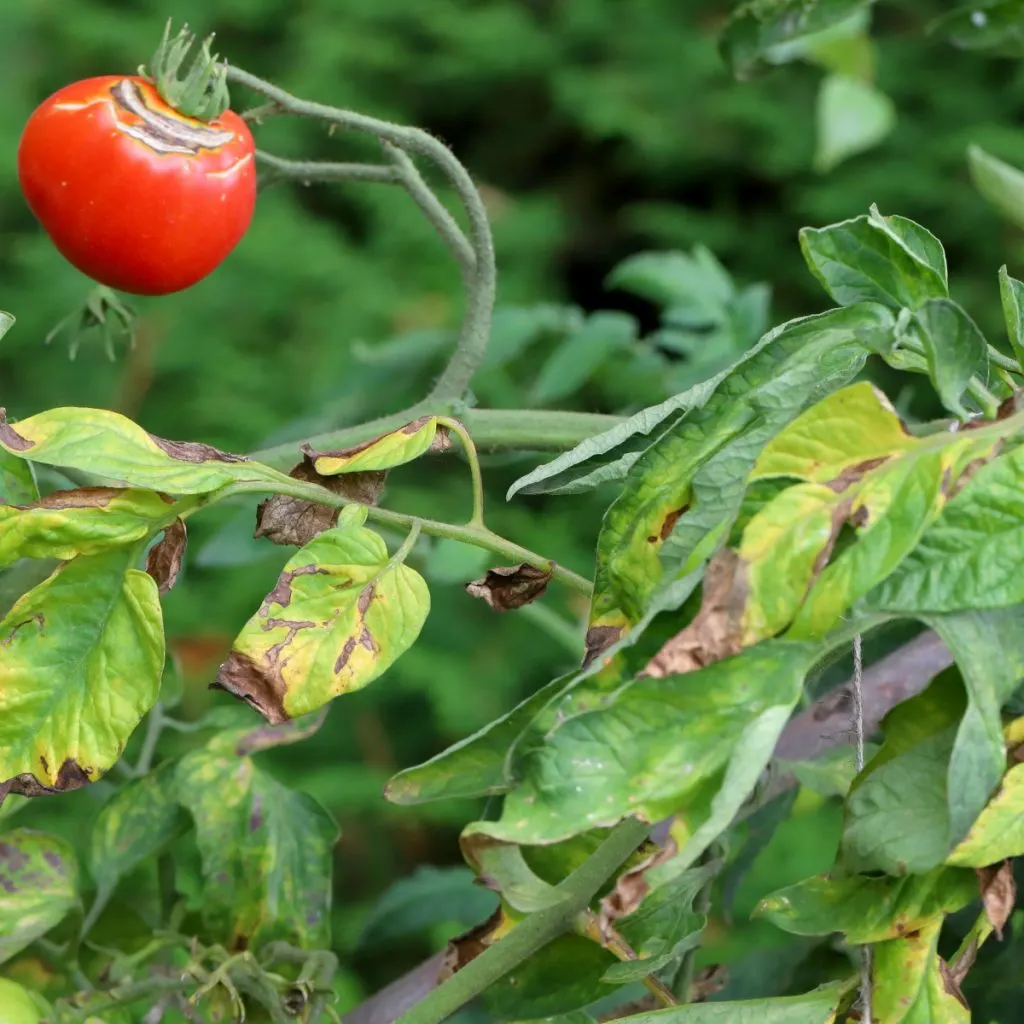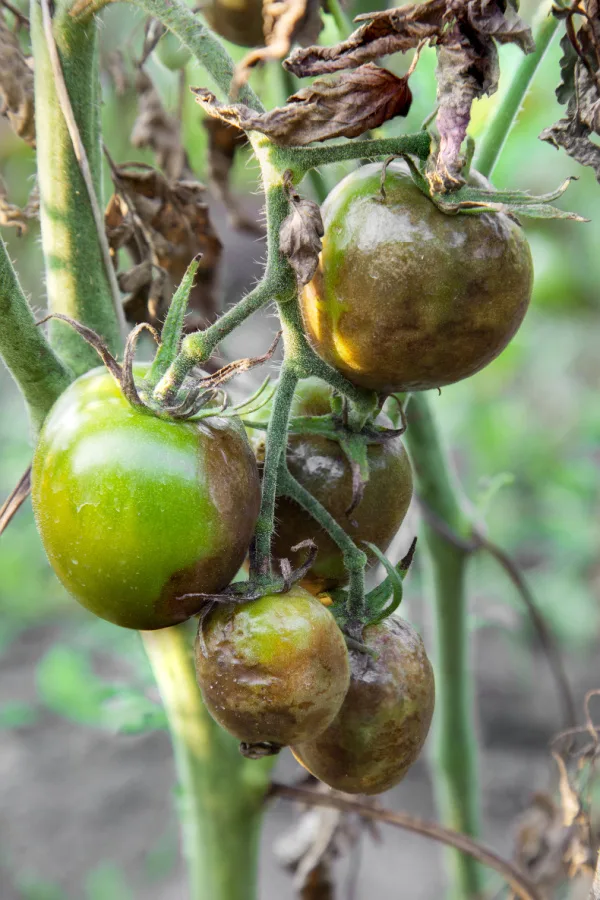When it comes to diseases that attack tomato plants, it’s hard to find one that can do more short and long term damage to a tomato crop than blight – which is exactly why preventing tomato blight and keeping your plants safe should be a top priority for anyone who loves to grow tomatoes!
When blight hits a tomato plant, it doesn’t just put this year’s harvest in jeopardy. Unfortunately, once the spores that cause blight are present, they can actually infect the soil where your tomatoes grew and harm next year’s plants. In fact, the spores can stay active in the same soil for as long as 5 years or more!
Making matters worse for tomato growers is that once blight appears, it can almost be impossible to stop. Although there are a few old-time remedies such as spraying your plants with milk that have shown to be effective in rare cases, for the most part, when a plant is hit with blight – its days are numbered.

Battling Early & Late Tomato Blight
There are two distinct types of blight – early season and late season. Early season blight is more prevalent when there has been an overly wet spring or early summer. It is not always fatal, but can put a serious dent in a tomato plant’s health and production.
Late season blight however is almost always deadly to plants. This is also the most common type of blight and can decimate an entire crop. Late season blight usually occurs in mid summer just as plants are fruiting. It starts by browning off leaves and eventually killing them. Next, it then spreads to the fruit as well, ruining it in the process.
Obviously, both early and late season blight can be devastating. And since either is almost impossible to cure – the most important way to keep your plants safe from blight is to prevent it in the first place. The good news? It can actually be fairly easy to do by simply following a few simple steps!
How To Keep Tomato Plants Safe From Getting Blight
Grow Blight Resistant Tomato Varieties
One of the easiest ways to prevent blight is by growing tomato varieties that are naturally resistant to it. This can be especially helpful if you have experienced blight in the past. And in the last few decades, several new tasty varieties of blight resistant tomatoes have been developed.

It’s important to note these varieties are not blight-proof. However, they all are bred and show a strong resistance to being affected by the spores that cause blight. Whether you like to grow beefsteak, slicing or paste tomatoes, there are blight-resistant varieties available that can help to fend off the disease.
When it comes to the best of the best, Magic Mountain is at the top of the list. Magic Mountain is a hybrid slicing variety that produces large quantities of round fruits around two inches in diameter. Best of all, the plant is highly resistant to both early and late blight. Affiliate Seed Link: Mountain Magic F1 Hybrid Tomato Seeds
Other Blight Resistant Tomatoes – How To Keep Tomato Plants From Getting Blight
If you are looking for a paste tomato variety with strong blight resistance, Plum Regal is a great choice. A Roma style hybrid, it has a strong resistance to a slew of diseases that can hit tomato plants. One note on Mountain Magic and Plum Regal seeds, as hybrids, you can’t save their seeds from year to year. This means you will have to repurchase seeds to grow again each season.
When it comes to non-hybrid heirloom tomatoes that show natural blight resistant, Mr. Stripey is an excellent choice. As an open-pollinated plant, this is one tomato plant that you can save seeds from and grow year after year. Affiliate Link: Mr. Stripey Heirloom Tomato Seeds

Rotating Your Tomato Crop – How To Keep Tomato Plants Safe From Getting Blight
In addition to planting tomatoes that are resistant to blight, the next most important thing you can do when it comes to prevention is to always rotate the location of where you plant your tomatoes from year to year.
Blight is caused from spores that infect the leaves of plants. And those spores live in the soil. By simply moving your crop each year, you decrease the likelihood that spores will be near your plants.
For the best protection, rotate your crops so that they never grow in the soil for at least 3 to 4 years. 5 is best, but it can often be hard to do with limited growing space. Rotating includes raised beds as well. Unfortunately, once blight is present in raised bed soil, unless you remove and replace the soil, it will continue to infect plants year after year.
Mulch Your Tomato Plants – How To Keep Tomato Plants Safe From Getting Blight
Because spores come from the soil to infect leaves, it’s important to always mulch the bare dirt underneath plants to help prevent spores from splashing up on the foliage.

A thick, four inch mulching of grass clippings or straw will do wonders to protect plants. This keeps plants safe from having the spores splash up from rain, hand watering – or even blowing winds. Mulch also benefits tomato plants by keeping weeds out and retaining moisture in the soil.
Another great way to help your plants is to prune the bottom leaves and stems from your tomato plants. This keeps the foliage from being a low and easy target for spores to find a home.
What To Do With Tomato Plants – How To Keep Tomato Plants Safe From Getting Blight
As a final note, what you do with your tomato plants at the end of the growing season can also help to keep blight from taking hold the following season.
Tomato plants are notorious for carrying all kinds of disease, beyond just blight. For this reason, you should always leave them out of your compost pile at the end of the growing season. Why? Because home compost piles usually can’t reach hot enough temperatures to kill blight spores or other pathogens in the pile that can bring harm to plants.

If blight spores or other types of disease are present on the plants, they can stay alive and end up wherever you use the compost in the garden next year. And if it’s on or near tomato plants, blight can easily take hold.
For the same reason, never put cuttings from mid season tomato pruning in your compost pile either. It is far safer to bag the plants up and take to a community composting facility, where they can safely be composted. If not available, you can also burn or bury the plants away from the garden.
Here is to keeping your tomato plants safe from getting blight – and to having a great tomato harvest this year!
I Grow Tomatoes
Follow Our Facebook Page For Even More Great Tomato Growing Tips! I Grow Tomatoes Facebook Page
I Grow Tomatoes is a website created for those who love all things about tomatoes – from planting and growing – to cooking and canning! We publish two articles every week, 52 weeks a year. Sign up today to follow via email! This article may contain affiliate links.
